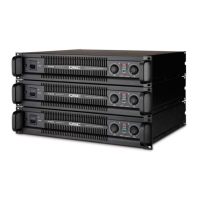32 QSC Audio Products, LLC
Figure 3.1 IGBT gate drive waveforms
Classifying Failures
Most amplifier failures divide generally into two categories:
1. Serious—Problems that keep the amplifier from running or that
cause catastrophic failure; these must be diagnosed using the
service fixture. Typical indicators of serious amplifier failure
include blowing a circuit breaker or fuse and/or emitting a
burning smell or smoke.
2. Minor—The amplifier runs without excessive losses, but with
incorrect or reduced performance.
Troubleshooting Serious Failures
NOTE: The audio circuits of channels 1 and 2 are identical. For
simplicity, the PL380 troubleshooting instructions describe only
channel 1’s components. See the schematic diagrams to identify the
corresponding components on channel 2.
What to look for
Symptoms may include one or more of these:
• The amplifier draws excessive current; it may trip circuit breakers
or blow fuses.
• The amplifier’s switch-mode power supply (for example, the
IGBTs and their control circuit) has failed.
• One or more output FETs and/or its control circuits have failed.
Possible situations
Overvoltage failure: If the amplifier has been operated with an
excessively high AC voltage (>140 V for 120 V models, or >280 V for
230 V models), these components may be damaged and require
replacement:
• Capacitors C190 and C191 may have vented.
• The TOP switch supply U41 and diode D66 may have been
damaged.
• The primary winding of transformer T1 may be open.
Excessive current draw: If the amplifier draws excessive current
at low AC voltage:
• Check for possible shorts in AC rectifier BR1 (schematic: see
sheet
“Power Supply, PL380,”
zone D-6), or the IGBT switches
Q68 and Q69 (zone D-4), or the clamp diodes D86 and D87 (zone
D-4).
• Also check the line filter components and wiring, especially the
120 V/240 V configuration (for 120 V, J22 connects to J15 and
uses a jumper at W1; for 240 V, J21 connects to J15, with no W1).
Failed switch-mode power supply: If you suspect that the
switching supply IGBTs Q68 and Q69 (QSC part # QD-000315-00) are
damaged:
• Always remove and replace both IGBTs as a pair whenever one
or both fails. Do this even if one appears to be okay. If either
IGBT is damaged, check the gate coupling resistors R293 and
R294 for possible open circuits; check diode D106 for a possible
short. Confirm that the windings of T4 are intact. U46 may also
be damaged.
Note: The PL380 uses a special type of IGBT with internal isolation.
No mounting film or insulation is required. Use only thermal grease
between the IGBT and the mounting surface of the heat sink. Use
only the exact replacement part, IXGR60N60C2 (QSC part number
QD-000315-00).
• Inspect and repair damaged or burnt traces, if needed. For best
results, always replace R293, R294, R290, R291, U46, and D106
when replacing blown IGBTs. On amplifiers made after January
2008, there also are fuses to replace, F5 and F6. With the AC
voltage completely shut off, check gate drives at each IGBT by
using the service fixture to power the control circuits via TEST
PORT-A and TEST PORT-B. Confirm that the IGBT gate drive
waveform is correct, as shown in Figure 3.1.
Check the drive waveform at the gate of each IGBT (schematic: see
sheet
“Power Supply, PL380,”
zone D-4), Q68 and Q69. Confirm that
3.1 PL380: Symptoms, causes, and remedies (continued)
SAFETY WARNING
The primary and secondary reservoir capacitors are not
covered. They store dangerously high voltages during
operation and for some time after power is turned off.
Do not touch them until they are fully discharged.

